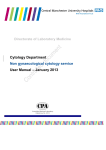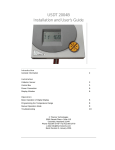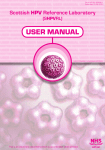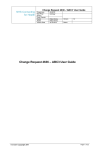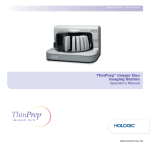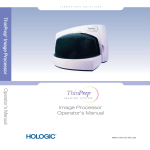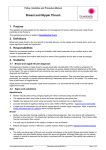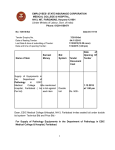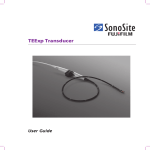Download MANCHESTER CYTOLOGY CENTRE USER MANUAL 2010
Transcript
Version 004 Directorate of Laboratory Medicine MANCHESTER CYTOLOGY CENTRE USER MANUAL 2010 January 2010 1 Version 004 Table of contents About us Services available at the Manchester Cytology Centre Services provided to the Christie Hospital Find or contact us at Manchester Cytology Centre Hours of opening at Manchester Cytology Centre Key personnel at Manchester Cytology Centre Find or contact us at the Christie Hospital Specimen acceptance policy Section 1 Non-Gynaecological Cytology Turn around time Non-gynaecological cytology sample collection: • Body cavity fluids (pleural/ascitic/peritoneal/peritoneal) • Cyst fluid • Respiratory tract samples (Sputum/Bronchial lavage/wash/trap/BAL & brush) • Urinary tract samples (Voided, catheter/urethral washings/ileal conduit/industrial urine) • Cerebrospinal fluid • Fine needle aspiration cytology Section 2 Gynaecological Cytology Quality Statement General Enquires Specimen collection and transport ‘Hub and Spoke’ arrangements for sample processing LBC Kits Completing the request form and labelling the sample vial Report generation and distribution Urgent referrals for further investigation Prioritising the workload (turn around time) Audit Feedback on inadequate cytology reports Research activities HPV Triage in primary screening – Sentinel Site Implementation Project Protocol for Cervical Screening Patient management protocol for the cervical screening programme Follow-up after total hysterectomy Guidelines for management of negative vault samples Preparing a ThinPrep™ LBC sample Preparing a SurePath™ LBC sample Appendix 1 – NHS Cervical Screening Programme request form Appendix 2 – Manchester Cytology Centre non-gynaecological request form January 2010 3 3 3 3 4 4 4 4 5 - 12 6 7 7 8 9 9 10 13 – 22 14 14 14 14 14 15 15 15 15 16 16 16 16 17 18 19 20 21 22 23 24 2 Version 004 About us The Manchester Cytology Centre is the largest unit of its kind in the country. It accepts ThinPrep and SurePath Liquid Based Cytology samples as part of the NHS Cervical Screening Programme, fine needle aspiration (FNA) cytology samples as well as other non-gynaecological specimens. We also provide a nongynaecological service to the Christie Hospital NHS Foundation Trust. The department is housed in a new building with state-of-the-art facilities and is affiliated to the Manchester Cytology Training Centre, which is situated on the ground floor of Clinical Sciences Building 2. The department is CPA accredited. We are fully committed to maintaining this accreditation by an established quality management system and standards determined by the North West Quality Assurance Centre together with scheduled clinical and quality audits. Services available at the Manchester Cytology Centre Non-gynaecological Cytology 1. Exfoliative and aspiration cytology 2. Fine needle aspiration cytology Gynaecological Cytology • • Services provided to the Christie Hospital Non-gynaecological Cytology 1. Exfoliative and aspiration cytology 2. Fine needle aspiration cytology • Find or contact us at the Manchester Cytology Centre The Manchester Cytology Centre is located on the first floor of Clinical Sciences Building 2. All visitors should access the department via the reception area of Clinical Sciences Building 1. Address Manchester Cytology Centre First Floor Clinical Sciences Building 2 Manchester Royal Infirmary Oxford Road Manchester M13 9WL Email [email protected] Enquiries General Gynaecological results Non-gynaecological results Booking an FNA Advice on non-gynaecological sample collection January 2010 Telephone 0161 276 5111 0161 276 5111 0161 276 5115/5116/6727 0161 276 5111 or Bleep 0765 950 3113 0161 276 5118/5108 Fax 0161 276 5149 3 Version 004 Hours of opening The department is open from 8.00 am – 5.00 pm, Monday to Friday (except bank holidays) Non-gynaecological samples should be received in the department by 4.45 pm. Consultant Cytopathologists Dr M Desai, Clinical Head of Cytology & Director of the Manchester Cytology Training Centre Tel: Dr M Holbrook Dr M Perera Dr D N Rana 0161 276 5099 Fax: 0161 276 5113 0161 276 6475 0161 276 5109 0161 276 5108 Medical Secretaries Tel: 0161 276 5115/5119/6727 Consultant Biomedical Scientist/Hospital Based Programme Co-ordinator (Cervical Cytology) Mrs Janet Marshall 0161 276 5103 Laboratory Manager Yvonne Hughes 0161 276 5119 Find or contact us at the Christie Hospital We are located in the Bereavement Suite at Christie Hospital and are available between the hours of 09:00 hrs to 12:30 hrs, Monday to Friday (except bank holidays). One staff member is available for FNA services and answer queries relating to non-gynaecological cytology only. Pease note that no results can be issued from this site. Telephone enquires 0161 446 3643 E mail [email protected] Specimen acceptance policy All specimen containers must be clearly labelled with the patient’s full name, date of birth/NHS or Hospital number and specimen type (non-gynaecological). Each specimen must be accompanied by a completed and matching sample request form. Please ensure all fields of request forms are completed. See appendix 1 and 2 for cervical cytology and non-gynaecological request forms respectively. Alternatively, we can supply bulk forms on request. January 2010 4 Version 004 Section 1 Non-gynaecological cytology January 2010 5 Version 004 Turn around time • Non-gynaecological cytology reports are printed and sent out daily, addressed to the consultant or clinician who requested the test. • To discuss the cytology report with the consultant cytopathologist contact the department between 8:00am and 5:00pm on 0161 276 5115/5116 Urgent specimens • Urgent specimens will be reported at least verbally within three (3) working days of receipt by the laboratory. Please provide a contact number or bleep and name. • This may only be a provisional report pending further ancillary tests. • It is recommended that the requesting clinician discuss such specimens with the cytopathologist between 8:00am and 5:00pm on 0161 276 5115/5116. In all cases, the clinician should telephone the laboratory in advance and provide a contact name and phone or bleep number. Routine specimens • Routine specimens will be reported within five (5) working days of receipt. This may vary depending on the specimen type and if additional clinical information or ancillary tests are required e.g. immunocytochemistry January 2010 6 Version 004 Non-gynaecological cytology sample collection Serous fluid samples Please see specimen acceptance policy on page 4 Body cavity fluids (pleural/ascitic/peritoneal/pericardial) • The sample should be aspirated with a fine bore needle and a 50ml syringe. • 50-100mls fluid should be sent in a clean dry container with screw cap (Note: no Formalin or alcohol should be added to the sample as both of these can cause interference with adherence to slide and quality of staining) • The fluid should be submitted as soon as possible to minimise cell deterioration, so that cell preservation is not compromised. If there is a delay in delivering the sample to the laboratory, the sample should be kept in a fridge at 4°C (Note: the sample should NOT be frozen) Cyst fluid • Cyst fluid should be put into a clean dry container with screw cap. • The sample should be sent as soon as possible in order to minimise cell deterioration. However, if there is a delay in the sample being delivered to the laboratory, it should be kept in a fridge at 4°C (Note: the sample should NOT be frozen) January 2010 7 Version 004 Respiratory tract samples Please see specimen acceptance policy on page 4 Sputum • • • • • Best results are achieved with freshly obtained sputa following chest physiotherapy, with an early morning sputum before the patient has eaten Contamination with large amounts of saliva or food leads to inadequate specimens Multiple specimens (usually x 3) may be necessary, but these should be sent on 3 separate days, not all taken at the same time Send in clean, dry container with screw cap If examination for eosinophils is required please indicate this on the request form Bronchial lavage, wash, trap and bronchoalveolar lavage samples • • Fresh specimen should be placed in clean dry container without fixative Delay in receipt can lead to deterioration of specimen Bronchial brush samples • • • • • Place brush into screw capped container with CytoLyt® transport medium which is available from Cytology department on request (0161 276 5115) Prior to sampling, decant an appropriate volume of CytoLyt® transport medium into a labelled CytoLyt® specimen container. This volume should be adequate to cover the bristles of the brush After sampling, place brush promptly into specimen container. Please ensure cap is screwed on tightly CytoLyt® transport medium must be stored in an flammable container DO NOT USE FORMALIN FIXATIVE Transbronchial FNA – see FNA section January 2010 8 Version 004 Urinary tract samples Please see specimen acceptance policy on page 4 Urine (including voided, catheter, urethral washings and ileal conduit samples) • • • • • Collect urine in a clean, dry container with a screw cap. A 20ml to 50ml container is suitable. An adequate urine sample is the second voided of the day, preferably mid morning or random A first voided sample is unsuitable for cytology analysis. Urine can be collected from catheters as well as washings from the bladder or upper urinary tract. The request form must state the method of collection. If there is a delay in delivering the sample to the laboratory, the urine sample should be kept in a fridge at 4ºC. Industrial Urine samples • • • The preferred method for the collection of industrial urine samples is the same as above. Since a majority of the samples are collected at home, it is recommended to put the sample into PreservCyt™ (transport medium), which should be provided by the requesting clinician. This method prevents the degeneration of cells while the sample is being transported to the laboratory. Cerebrospinal fluid (CSF) Please see specimen acceptance policy on page 4 • • • • A clean, dry container with screw cap should be used. CSF samples are liable to degenerate rapidly and as such must be prepared immediately. Please contact the laboratory to inform staff of imminent arrival of a CSF sample. Latest processing time for samples is 15.30pm Mon-Fri. Please try to send samples at least half an hour before this time. If out of hours sampling is unavoidable, storing the sample in refrigerator at 4°C may help preserve cells for up to 24 hours. January 2010 9 Version 004 Fine needle aspiration cytology samples The staff in the laboratory will be pleased to advise on any aspect of sample collection, please contact the department at • Manchester Cytology Centre between 8:00am and 5:00pm on 0161 276 5111/ 5115/5116. We may also be contacted by bleep number 0765 9503 113 Please note calls must be received by 3.45pm for FNA attendance. • Christie hospital – FNA clinics Monday to Friday 9:00am to 12:30pm It is recommended that the support of a BMS be utilised for optimal sample preparation Use of fine needle aspiration . • Patients presenting with palpable lesions in clinics (ENT, maxillofacial), outpatients and wards. • Deep seated lesions sampled by guided techniques (Ultra Sound, CT) • Endoscopic and Transbronchial guided specimens Radiology, Endoscopy, Respiratory Medicine and Head & Neck (ENT and Maxillofacial) departments please book with the Manchester Cytology Centre in advance. Equipment required for a fine needle aspiration • Standard disposable 21-25 gauge needles. A 25 gauge needle is suitable for most lesions. • Disposable 5-10 ml plastic syringe. • Clean container with tight lid (preferably universal) containing saline or Cytolyt™ if available • Standard microscopic glass slides onto which aspirate is to be smeared • Commercial spray fixative for wet fixation of smears Completion of request form and sample container Please see specimen acceptance policy on page 4 Do not refrigerate please. and FNA cytology reports January 2010 10 Version 004 How to perform a fine needle aspiration • Disinfect skin using pre-packed alcohol swabs. • Before insertion of needle wipe away any excess ultrasound jelly with tissue paper (if U/S guided) • Perform the aspiration according to the instructions A - G A Position needle within target tissue B Pull plunger to apply negative pressure C Move needle back and forth inside target D Release negative pressure while needle remains in target tissue E Withdraw needle F Detach needle and draw air into syringe G Push a drop of sample onto microscopy slide Figure taken from Fine Needle Aspiration. (2005), 4th Edition. S. Oreell; G.F. Sterrett; and D. Whittaker. Elsevier Churchill Livingstone. January 2010 11 Version 004 • 2 fine needle aspirations are recommended where possible. • If Tuberculosis is suspected, please also send an aspirate to microbiology in a sterile container. • If a reactive lymph node or lymphoma is suspected please send a 3rd aspirate for flow cytometry analysis in RPMI transport medium which can be provided by the BMS. The ideal FNA sample is prepared as follows: • Even monolayer spreads onto glass slides for 1) air-dried ‘direct smear’ and 2) alcohol fixed ‘direct smear’ • The needle is rinsed in saline or CytoLyt® collection fluid for optimal cell preservation of residual material. Note: saline is acceptable if the correct transport medium is not available. However as saline is not a preservative solution these specimens must be received by the laboratory as soon as possible January 2010 12 Version 004 Section 2 Gynaecological cytology January 2010 13 Version 004 NHS CERVICAL SCREENING PROGRAMME QUALITY STATEMENT The Manchester Cytology Centre is a CPA accredited department and all cervical liquid based cytology (LBC) samples are processed and screened following NHS Cervical Screening Programme guidelines and the regional Quality Assurance Reference Centre recommendations. The department participates in the regional gynaecological and technical EQA schemes and the performance of all screening staff is assessed quarterly as per NHSCSP guidelines. The management and staff within the department are committed to providing a quality service to our users. We aim to continually improve our service through internal audit and feedback from users. If you do have a complaint or concern about any aspect of the service, this should be addressed to the laboratory manager on 0161 276 5119. General enquiries Tel: 0161 276 5111 Fax: 0161 276 5149 A consultant cytopathologist or a consultant biomedical scientist is available to answer any ‘gynaecological queries’ and discuss any aspect of the cytology report as well as give advice on patient management. Specimen collection and transport The Manchester Cytology Centre processes and reports both ThinPrep® and SurePath® cervical LBC samples. These should only be collected by trained sample takers. Training in sample collection for primary care staff is available on request from the cytology training leads at the local Primary Care Trust. The cytology lead can also arrange for three-yearly update training for sample takers in order for them to remain aware of developments within the cervical screening programme and to maintain competence. Instruction sheets on sample collection are also available from the laboratory. A courier service will deliver LBC kits and collect LBC samples on a daily basis. If there are any issues relating to the courier service please, contact the laboratory manager on 0161 276 5119. ‘Hub and spoke’ arrangements for sample processing The laboratory has a large capacity for LBC sample processing. As such it functions as a one of two ‘hub’ laboratories, processing LBC cervical samples on behalf of a number of ‘spoke’ laboratories in the Greater Manchester region such as Stepping Hill Hospital in Stockport, Tameside General Hospital and Macclesfield District General Hospital. Both ThinPrep® and SurePath® cervical LBC samples are prepared and the resulting slides returned to the spoke laboratories for reporting. LBC kits The laboratory uses a database to keep a record of the number of LBC kits used by each surgery and clinic to ensure that supplies are readily available. For any enquiry regarding LBC kits please contact the laboratory on the general enquiries number – 0161 276 5111 January 2010 14 Version 004 Completing the request form and labelling the sample vial Request form: The request form should be completed in full with all information PRINTED legibly. Relevant clinical information should be printed clearly on the form. The NHS number should be used whenever possible as this is the unique patient identifier. The sample taker is required to print their name in block capitals in order for the laboratory to assign the correct PIN code. PIN codes are created by the laboratory office manager and recorded against each test. The laboratory is required to record sample taker details and the PIN code allows periodic audit of this information. Sample: The label on the sample vial should record the forename, surname and date of birth to allow matching of the vial with the request form in the laboratory. After collection and labelling, the sample and request form should be placed in separate sections of the plastic specimen bag provided before dispatch to the laboratory. Vaginal vault samples Women who need vaginal vault cytology following surgery are no longer included in the NHS Cervical Screening Programme. The recommendation from the North West Cervical Screening Quality Assurance Reference Centre (March 2009) is that vault cytology should be performed with a colposcopic examination and therefore women requiring this should be referred to colposcopy. Vulval samples These are not considered part of the NHS cervical screening programme. If a sample has been collected using the Cervix-Brush® it is rinsed or placed into the LBC vial, depending on the system being used. Report generation and distribution Printed reports are sent to the surgery or clinic where the sample was collected. Copy reports are sent to Call/Recall agency at the Primary Care Trust (PCT) and the woman’s GP (when the GP practice is not the source of the sample). Unidirectional links are in operation between the laboratory and the Manchester, Salford & Trafford, Wigan and Bolton, and Bury Screening Agencies to allow electronic transmission of the cytology report. Other PCT’s receive a daily spreadsheet containing the cytology results. Urgent referrals for further investigation Any test reported as suspected invasive carcinoma or suspected glandular neoplasia requires urgent referral for further investigation, as these are possible cancer cases. The laboratory will contact the sample taker by phone and arrange to fax the report through to a ‘safe haven’ fax so that referral process can commence as soon as possible. A failsafe system is in place to ensure that the report has been received and the patient referred. Prioritising the workload The majority of samples received by the laboratory are taken as part of the NHS cervical screening programme. The national screening office has advised that laboratories should make the final report available to women within 14 days of sample collection. The laboratory is aiming to meet this new national target by 2010 for all samples, regardless of the source e.g. primary care, colposcopy. January 2010 15 Version 004 Audit The department participates in the Trust audit programme and has a rolling programme of audit projects. Feedback on inadequate cytology reports The laboratory sends data to the regional Quality Assurance Reference Centre on a quarterly basis and samples takers can access the information on-line. To register for access to the sample taker database, contact QARC via their web site: www.nwcsqarc.org.uk or telephone Michael Wall at NWCSQARC on 0151 702 4284 RESEARCH ACTIVITIES ARTISTIC TRIAL - A Randomised Trial In Screening To Improve Cytology This HTA funded trial was to assess the use of HPV testing as a primary screening tool. Women between the ages of 20 to 64 were recruited to this trial. Their cervical sample was taken and processed by the ThinPrep® LBC system and from the clinical details section on the request form, the laboratory arranged subsequent HPV testing if required. The ARTISTIC trial is now complete and the report is to be published in 2010. MAVARIC TRIAL - Manual Assessment Versus Automated Reading In Cytology This HTA funded trial was to compare manual screening of cervical samples with the automated screening devices, FocalPoint (SurePath®) and Imager (ThinPrep®). The trial included HPV testing to determine patient management The trial comprised: Randomisation to either manual assessment only, or manual assessment AND automated reading HPV testing if the cytology result is borderline or mild dyskaryosis Visit our web page for more information about the MAVARIC trial which is due to report out late 2010 www.cmmc.nhs.uk/directorates/labmedicine/departments/cytology/ HPV TRIAGE IN PRIMARY SCREENING - SENTINEL SITE IMPLEMENTATION PROJECT The Manchester Cytology Centre has been selected as one of six national sentinel sites to begin the controlled implementation of HPV triage in primary screening. All women with first ever borderline or mild dyskaryosis results will be included and managed according to their HPV result. The new patient management protocols commenced in March 2008 Visit our web page for more information and copies of the Sentinel Site protocols www.cmmc.nhs.uk/directorates/labmedicine/departments/cytology/sentinel.asp January 2010 16 Version 004 Manchester Cytology Centre Protocol For Cervical Screening and Management (Revised January 2008) • Commence cervical smears after woman’s 25th birthday • No need to screen women under the age of 25 years • Continue routine 3 yearly recall between the ages of 25 – 49 years inclusive • Continue routine 5 yearly recall between the ages of 50 – 64 years inclusive • Cease smears at age 65 years, only screen those who have not been screened since age 50, or those who have had recent abnormal tests • Additional (unscheduled) smears are NOT justified in any of the following situations: Women with symptoms of cervical cancer should be referred for gynaecological examination: • • On taking or starting to take an oral contraceptive On insertion of an IUCD On taking or starting to take hormone replacement therapy In association with pregnancy – neither antenatally nor postnatally, nor after termination. In women with genital warts In women with a vaginal discharge In women with cervical/vaginal infection In women who have had multiple sexual partners In women who are heavy cigarette smokers One year after the first ever negative smear Postcoital bleeding in women over 40 years Intermenstrual bleeding Postmenopausal bleeding Persistent vaginal discharge Where there is a strong clinical suspicion of malignancy, refer to gynaecologist regardless of any smear report. January 2010 17 Version 004 PATIENT MANAGEMENT PROTOCOL FOR THE CERVICAL SCREENING PROGRAMME Management for women included in the Sentinel Site HPV triage can be obtained from http://www.cmmc.nhs.uk/directorates/labmedicine/departments/cytology/sentinel.asp Patient Management **excluding HPV triaged women** Cytology Report Negative Inadequate because endocervical cells are absent with a history of CGIN 1st Inadequate 2nd Inadequate 3rd Inadequate 1st Borderline changes + warty changes 2nd Borderline 3rd Borderline Follow-up after borderline changes: 1st Negative (taken at 6 months) 2nd Negative 3rd Negative Routine recall Repeat smear in 3 months Endocervical and ectocervical sampling is recommended Repeat in 3 months Repeat in 3 months Refer for colposcopy Repeat in 6 months Repeat in 6 months Refer for colposcopy Repeat in 6 months Repeat in 12 months Routine recall Note: there should be no more than 3 borderline results in any 10-year period without referral for colposcopy, regardless of the number of negative cytology tests in between 1st Borderline changes in endocervical cells 1st Borderline/high-grade dyskaryosis cannot be excluded Mild dyskaryosis Moderate dyskaryosis Severe dyskaryosis Suspected invasive carcinoma Suspected glandular neoplasia Refer for colposcopy Refer for colposcopy Refer for colposcopy Refer for colposcopy Refer for colposcopy Urgent colposcopy referral Urgent colposcopy or gynaecological referral depending on cell type Follow-up after referral to colposcopy for mild dyskaryosis or less (normal colposcopy & no treatment) 1st follow-up smear is negative 1st follow-up smear is borderline 1st follow-up smear shows dyskaryosis Return to routine recall Repeat in 12 months Refer back for colposcopy Follow-up after treatment of CIN 1 Cone biopsy, large loop excision (LLETZ) or local ablation 1st Negative (taken at 6 months) 2nd Negative 3rd Negative Repeat in 6 months Repeat in 12 months Routine recall Follow-up after treatment of CIN 2 and CIN 3 Cone biopsy, large loop excision (LLETZ) or local ablation 1st Negative (taken at 6 months) 2nd Negative 3rd Negative Subsequent negative smears Repeat in 6 months Repeat in 12 months Repeat in 12 months Repeat annually for a total of 10 years, then routine recall Follow-up after treatment of CGIN Cone biopsy, large loop excision (LLETZ) 1st Negative (taken at 6 months) 2nd Negative Subsequent negative smears Repeat in 6 months Repeat in 6 months Repeat at 6 monthly intervals for 5 years, then annually for 5 years, then routine recall Refer back for colposcopy if: Two follow-up cytology tests show borderline changes OR one follow-up cytology test shows dyskaryosis Follow-up after treatment for invasive cervical cancer (excluding hysterectomy) Without radiotherapy Repeat in 6 months, then annual smears for 10 years and then routine recall unless specialist opinion indicates otherwise January 2010 18 Version 004 FOLLOW UP AFTER TOTAL HYSTERECTOMY Where there is no CIN or invasive cervical cancer on histology For women on routine recall for at least 10 years prior to hysterectomy: Suggest cancel recall. For women on routine recall for less than 10 years prior to hysterectomy: Take vault smear at 6 months, then suggest cancel recall if negative. For fully excised CIN Suggest cancel recall after 2 subsequent negative cytology tests at 6 months and 18 months after surgery. For fully excised CGIN Suggest cancel recall after 2 subsequent negative cytology tests at 6 months and 18 months after surgery. For incomplete, unspecified, uncertain or unknown excision of CIN 1 Follow-up cytology tests at 6 and 12 and 24 months. If all are negative, return to routine recall. For incomplete, unspecified, uncertain or unknown excision of CIN 2 or CIN 3 Follow-up cytology tests at 6 and 12 months. Then annual follow-up for a total of 10 years. If all are negative, return to routine recall. For incomplete, unspecified, uncertain or unknown excision of CGIN Follow-up cytology at 6 and 12 months. Then 6 monthly cytology for a total of 5 years. Then annual cytology for a further 5 years. If all are negative, return to routine recall. For invasive cervical carcinoma (no radiotherapy ) Follow-up at 6 and 12 months, then annual cytology for a further 9 years. If negative, routine recall unless specialist opinion indicates otherwise. Follow-up after radiotherapy No need for follow-up cytology unless specialist opinion indicates otherwise. For endometrial /ovarian carcinoma Suggest cancel recall unless specialist opinion indicates otherwise. References • NHSCSP Publication No 1, Achievable Standards, Benchmark for Reporting. Criteria for Evaluating Cervical Cytopathology, October 1995 & May 2000 • NHSCSP Publication No 8, Guidelines for Clinical Practice and Programme Management, December 1997 • ABC 2 - A Regional Guide to Implementation • NHSCSP Publication No 20, Colposcopy and Programme Management 2004 In July 2005, the North West Regional Quality Assurance Reference Centre issued additional guidance for follow-up cytology after radical hysterectomy and radiotherapy for the treatment of cervical cancer Women who have undergone radical hysterectomy for cervical cancer: In general, cytological follow-up is not recommended in the assessment of these women but decisions regarding this small group of patients should be determined by the gynaecological oncologist who carries out the procedure Women who have undergone radiotherapy for the treatment of cervical cancer: Cervical or vaginal vault cytology should not be performed on women who have undergone radiotherapy as part of their treatment January 2010 19 Version 004 Guidelines for Management of Negative Vault Cytology (All vault samples must be taken at colposcopy)1 Total Hysterectomy (entire cervix removed) No Yes Part or all of the cervix remains? Evidence of cervical disease on histology? No Yes Follow-up/recall as for cervical screening Yes Less than 10 yrs on routine recall At least 10 yrs on routine recall Vault cytology at 6 months then suggest cancel recall Suggest cancel recall CIN or CGIN completely excised? Yes Suggest cancel recall (2) after 2 subsequent negative cytology tests at 6 and at 18 months Invasive cervical cancer CIN or CGIN No With radiotherapy Without radiotherapy Suggest cancel recall Vault cytology at 6 & 12 months then annual cytology for 9 years. If all negative, routine recall Incomplete, unspecified, uncertain or unknown excision of CIN or CGIN Follow-up as though the cervix were still in situ (i.e. low grade or high grade CIN follow-up) 1. North West Cervical Screening Quality Assurance Reference Centre Guidelines (March 2009) January 2010 20 Version 004 Manchester Cytology Centre PREPARING A THINPREP LBC SAMPLE IMPORTANT NOTICE If the broom head is left in the vial the sample will be reported as inadequate OBTAIN… an adequate sample from the cervix using a broom-like device. Insert the central bristles of the broom into the endocervical canal deep enough to allow the shorter bristles to fully contact the ectocervix. Push gently, and rotate the broom in a CLOCKWISE direction FIVE TIMES RINSE… the broom into the PreservCyt solution vial by pushing the broom into the bottom of the vial 10 TIMES, forcing the bristles apart. As a final step, swirl the broom vigorously to further release material. Examine the broom for residual material and repeat if necessary. DISCARD THE BROOM – DO NOT LEAVE THE BROOM HEAD IN THE VIAL TIGHTEN… the cap so that the torque line on the cap passes the torque line on the vial For further copies, please contact the Manchester Cytology Centre on: 0161 276 5111 www.thinprep.com January 2010 21 Version 004 Manchester Cytology Centre PREPARING A SUREPATH LBC SAMPLE IMPORTANT NOTICE If the broom head is not present in the vial the sample will be reported as inadequate COLLECT… an adequate sample from the cervix using a broom-like device. Insert the central bristles of the broom into the endocervical canal deep enough to allow the shorter bristles to fully contact the ectocervix. Push gently, and rotate the broom in a CLOCKWISE direction FIVE TIMES DETACH THE BROOM HEAD… by placing your thumb against the back of the broom head. Push the broom head from the stem into the SurePath preservative vial THE BROOM HEAD MUST BE PRESENT IN THE VIAL CAP THE VIAL… securely so that it does not leak For further copies please contact the Manchester Cytology Centre on: 0161 276 5111 www.surepath.com January 2010 22 Appendix A Version 004 Signature January 2010 Smear taker full name (PRINTED) GP name and full postal address Date Sender code 1 Normal 2 Ectopy 3 Cervicitis 1 Pregnant 2 Postnatal (< 12 weeks) 3 IUCD 1 Postcoital bleeding 2 Postmenopausal bleeding 3 Intermenstrual bleeding 4 Irregular bleeding X5 23 ……………………………………………………………..……………………. …………………………………………………………………………………... …………………………………………………………………………….…….. …………………………………………………………………………….…….. CLINICAL DETAILS (include relevant details i.e. signs, symptoms, previous abnormal cytology with dates, details of previous histology, type of biopsy, treatment etc PRINTED CLEARLY) TOTAL HYSTERECTOMY (tick box if yes) HAEMORRHAGE 7 Other 4 Other hormones (specify) 5 Oral contraceptives 6 Postmenopausal 360 DEGREE SWEEP OF CERVIX 4 Polyps 5 Malignant 6 Stenosis 7 Prev inadequate smr 8 Opportunistic smear 9 Other 2 Endocervical sampler 2 Vaginal vault 4 Prev abnormal smear 5 Prev biopsy/treatment 6 Annual smears For laboratory use only 1 Cervex-Brush® (Broom) 1 Cervix 1 First test 2 Routine recall 3 Clinically indicated _____/_____/_____ CERVIX FULLY VISUALISED (tick box if yes) APPEARANCE OF CERVIX CONDITION Hospital / Clinic Number Lab Patient’s Use Address only Post code SPECIMEN SITE Sender name and full postal address – IF NOT GP – (include ward or clinic etc) SAMPLING DEVICE DATE OF BIRTH REASON FOR SMEAR Previous test date PREVIOUS SURNAME FORENAME(S) SURNAME ** PRINT PATIENT INFORMATION CLEARLY TO PREVENT ERRORS ** **NO CORRESPONDENCE TO HOME ADDRESS** (tick box) NHS NUMBER Date of LMP (1st day) _____/_____/_____ CERVICAL CYTOLOGY REQUEST FORM _____/_____/_____ Date of smear THE MANCHESTER CYTOLOGY CENTRE NHS Cervical Screening Programme request form Version 004 Appendix B: Manchester Cytology Centre Non-Gynaecological Cytology Request Form PATIENT’S DETAILS:(AFFIX STICKER HERE) SPECIMEN DETAILS: (PLEASE TICK) Surname URINE Voided [ ] Catheterised [ ] Post instrumentation [ ] Bladder washings [ ] Ureter [ ] Forename Ileal conduit [ ] Address Sex BODY CAVITY Ascitic Fluid [ ] Peritoneal Fluid [ ] Pericardial Fluid [ ] Peritoneal Washings [ ] Pleural Fluid [ ] DOB Private/NHS Hospital/NHS number MISCELLANEOUS Cyst Fluid (other) [ ] Please state site CSF [ ] GASTROINTESTINAL Pancreatic cyst fluid[ ] - Biochemistry sent[ ] - No biochemistry[ ] Biliary brushings [ ] - Stent present[ ] - Stent absent [ ] FNA SITE & SIDE (Lt or Rt): CT Guided [ ] Ultrasound Guided[ ] Endoscopic U/S Transduodenal [ ] Transgastric [ ] Transbronchial [ ] OTHER Please give details Ward/Dept Consultant to whom the report is to be sent (please print): Copy report to/ Department (please print): Consultant’s department where report is to be sent: Time taken: Bleep/contact number (for requesting clinician): Date taken: Head and Neck FNAs. Please indicate area and label diagram below CLINICAL INFORMATION Clinical History ……………………………………………. Right Left ………………………………………………………………. Significant Findings…………………………………………. ……………………………………………………………….. Diagnosis…………………………………………………….. Previous Cytology …………………………………………... Previous Histology ………………………………………….. Previous Treatment Chemo/radiotherapy ………………………………………. High Risk Yes No Requesting/aspirating Clinician (PLEASE PRINT) ………………………………………………………………………… Signature and date……………………………………………………………………………………………………………….. NB: Insufficiently filled in forms will result in delay in the reporting of the specimen January 2010 24
























